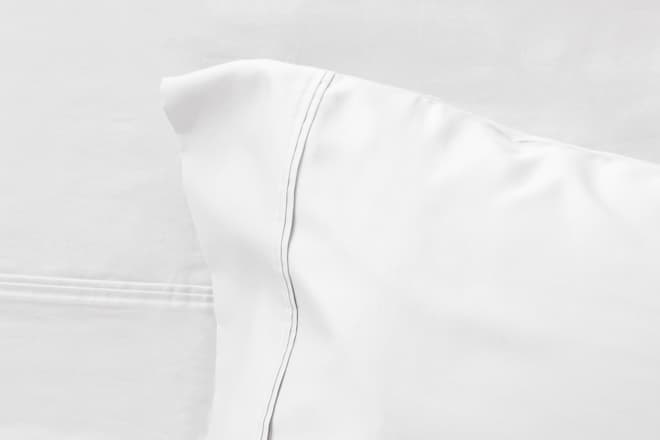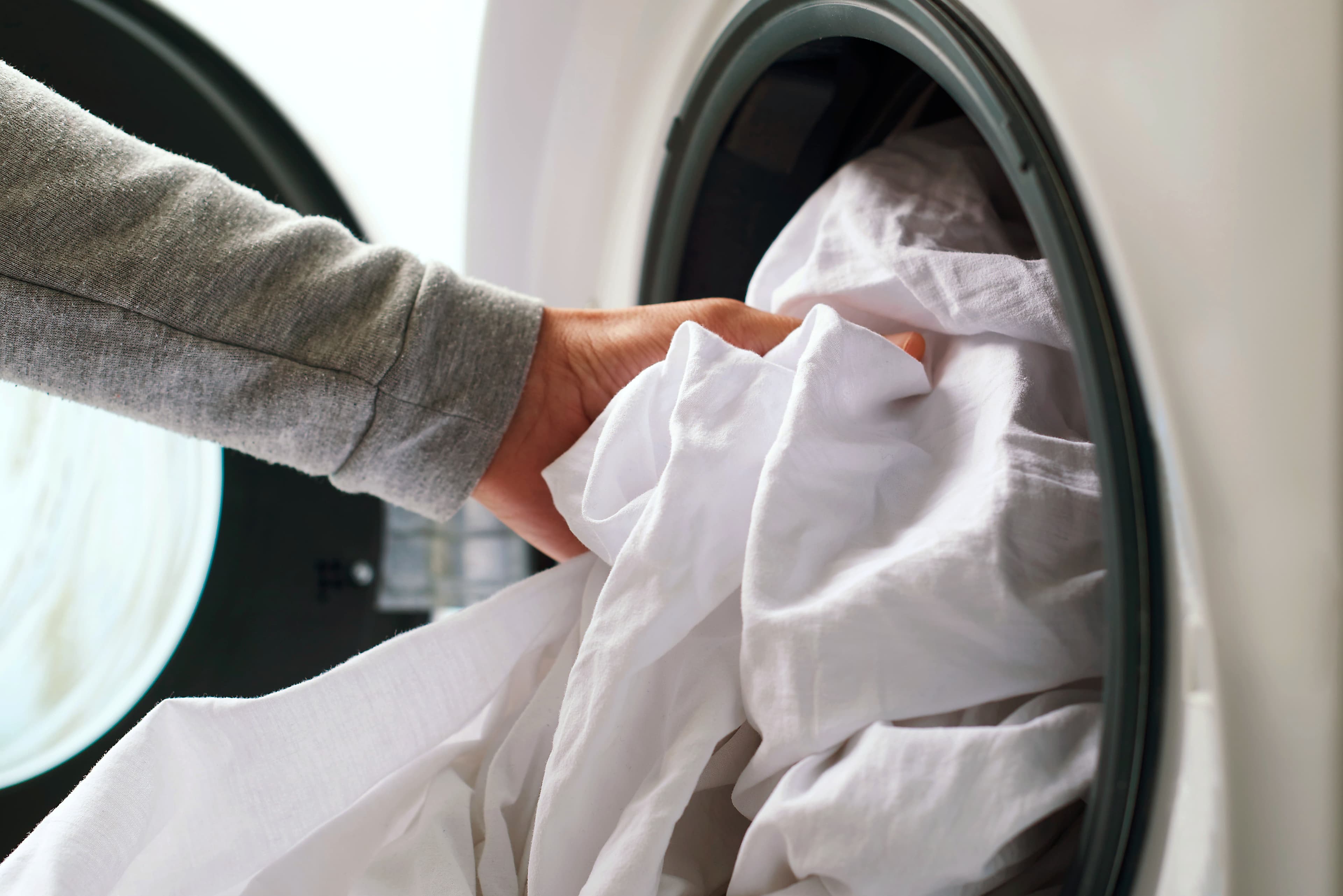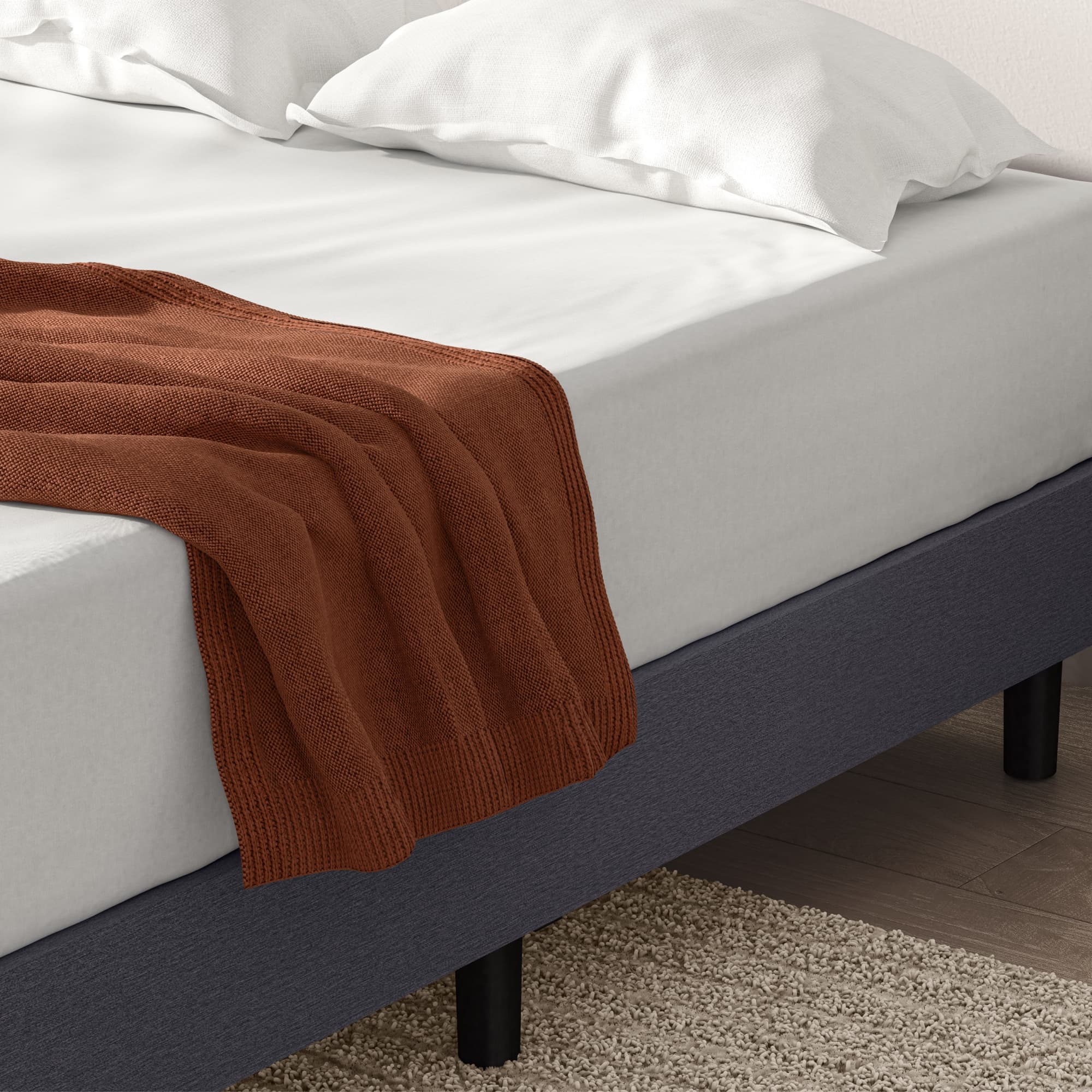Clean sheet day is the best, isn't it? It makes us go "yay laundry day!" Nothing feels better than climbing into a bed made up with a set of clean, fresh sheets. (We're feeling relaxed just thinking about it!) If those clean sheets are on a Leesa mattress, even better—you're bound for sleep-time bliss. You love your bed (and clean sheets), so we're talking all about how to keep your bed sheets clean and comfortable for long-lasting comfort.
How often should I wash sheets?
OK, first: this is a judgment-free zone. Let's get real. There are some people who wash and change sheets weekly without fail. There are others who do it more like every two weeks. And there are others who wash their sheets once a month. So who's right and who's wrong? How often should you actually wash your sheets?
When it comes to sleeping (or not sleeping), reading, binge-watching Netflix, or eating in bed, it's all about personal preference. The same can be said for washing sheets. After all, you're the one who has to sleep in them every night, not us.
That being said, most experts recommend laundering your sheets every one to two weeks and more often if you're a drooler or sweaty sleeper. If you only change your sheets once a month, that may seem like a lot, but think about it. Sheets catch sweat, body oils, dead skin cells, dust mites, dandruff, cracker crumbs, pet dander, bodily fluids, and whatever else they come in contact with.
So it's not a bad idea to wash them once a week, or at a minimum, at least every two weeks. What's even grosser is that dust mites feed on all that debris. And, if you sleep naked, your sheets get even dirtier with body oil and microscopic fecal material. Yuck!
Beware: if you're a once-a-month sheet changer, your dirty sheets may impact your health. Not only will sheets that go too long without being washed smell, but they can also make eczema flair, and cause hives, itching, and even asthma.
What's worse is this little fact: your dirty sheets can turn into a petri dish for bacteria. According to the BBC, dirty sheets can cause infections such as staph, forms of yeast, including jock itch and folliculitis, an infection of the hair follicles which causes extreme itching as well as red bumps.
Speaking of cleaning things more often, when was the last time you cleaned your foam mattress? Even if you have a mattress protector (you're so smart!), you should clean your mattress at least once a season with a vacuum attachment. That gets any dust, dirt, and skin cells deep in your mattress and can greatly extend the life of your mattress.
Types of Sheets
There are more types of bed sheets than you might realize--cotton sheets, Egyptian cotton sheets, silk and satin sheets, linen sheets, bamboo sheets, and more. Each type of sheet requires a different kind of care, so be sure to read the care instructions included with your sheet set. Different fabrics require different care.

How to Wash Cotton Sheets Properly
When it comes to choosing the right bed sheets, you should consider thread count and price, as well as how they feel to the touch. If you sleep hot, you may want lightweight cotton sheets. If you're usually cold at night, go for something thicker and warmer.
Whether you prefer a mega-luxe, high-thread-count sheet, or the lightweight feel of cotton or poly-blend sheets, keeping your sheets clean and comfortable is important and easy to do. Here are some tips for cleaning cotton and cotton-blend sheets:
Don't overcrowd your sheets in the washing machine with towels and other laundry. Give them room to move freely in the washer and dryer. By doing this, you preserve the quality and feel of the fabric and your sheets will last longer.
Wash bed sheets at cool to warm water temperatures (depending on your sheets) and with mild detergents. The cold water helps retain shape and color if you have brightly dyed sheets. So does use a gentle wash cycle.
Every once in a while, run your sheets in a hot wash cycle, especially if you or your partner has been sick.
You can use fabric softener or dryer sheets with cotton or poly-blend bedding.
Try not to use bleach, which can dry out and damage the weave of your sheets. Try alternatives to bleach, like lemon juice, which can be just as effective. Half a cup of lemon juice not only brightens white sheets and bedding but also imparts a lovely lemony scent.
Tumble dry your sheets on a medium setting. Again, it's important not to overcrowd your dryer so your sheets have plenty of room to fluff and dry. You can use a dryer sheet if you like.
Remove and fold your sheets promptly. This will keep them as wrinkle-free as possible. If you've left them in the dryer and they're a wrinkled mess, toss a damp towel in the dryer and run it on a short cycle to refresh them, or use your dryer's steam cycle to unwrinkle your bed linens.
Line drying your sheets gives them extra crispness and freshness. It's also ecologically friendly. If you're of a certain age, when sheets were always hung outside to dry, the aroma of those fresh-smelling sheets will be intoxicating.
How to Wash Bamboo Sheets Properly
Bamboo bedding requires a little TLC. They are ultra-soft and the equivalent of a 1000-count cotton sheet. Machine wash them in cold water and on the gentle wash cycle. It's preferable to use an organic and biodegradable liquid detergent. Avoid hot temperatures--these will shorten these sheets' life. Never wash bamboo sheets with other laundry or clothing. Zippers can wreak havoc on the gentle fibers. Bamboo is organic, hypoallergenic, as well as a natural disinfectant, so they tend to repel dust mites.
Avoid machine-drying bamboo sheets if at all possible. The best way to dry them is by hanging them up outside, or on a drying rack. If you must use a dryer, use a low heat setting and a gentle cycle. With proper care, bamboo bedding will last for years.
How to Wash Linen Sheets Properly
Wash linen sheets in cool water using the permanent press cycle for the best result. If there are spots pre-treat stains. You can use regular liquid detergent if you prefer. If you've ever had a linen shirt or pants, you know the more you launder linen, the softer it gets because it's made of natural fibers.
Linen is also a more persnickety fiber, similar to bamboo. Most makers of linen bedding recommend air drying. Or, you can try the air-dry setting on your dryer, using wool dryer balls. Remove the sheets from the dryer when they are slightly damp, and iron them dry.
How to Wash Silk and Satin Sheets Properly
Silk is actually quite easy to care for and can be machine washed on a delicate cycle, so long as you put them in a mesh bag first. Or, you can hand wash silk and satin sheets if you prefer. Always turn silk or satin pillowcases inside out before laundering. Using cold water is a must, as is using a gentle laundry detergent, preferably one designed for silk. Line dry silk and satin bedding, but if you hang them outside, avoid direct sunlight.
If you absolutely must machine dry silk bedding, do so on the air-dry setting, checking every five minutes or so since silk dries very quickly. Silk will unwrinkle after a day or two of use, but if you're a perfectionist (we understand!) you can iron this luxurious bedding at your iron's lowest setting inside out.
How to Fold Fitted Sheets
Folding a fitted sheet can be infuriating. But, you can do it! (We promise.) It just takes a bit of practice to master the art of folding a fitted sheet.
Remember, a folded fitted sheet is perfectly optional. It's also OK to get frustrated and not fold it up. You could also opt for the strip, wash, dry, replace method, the casual almost-fold method, or the no fold, no worries method. Again, personal preference. However, if you are striving for the perfect Instagrammable closet, here's how we like to fold our fitted sheets:
1. Take the fitted sheet out of the dryer as soon as the cycle ends to prevent wrinkles.
2. Shake the sheet as flat as it gets and place it on a flat surface.
3. Take the two corners on one of the longer sides of the sheet and fold them over to match the other side, cutting the size in half lengthwise (like a hot dog, not a hamburger!)
4. Tuck one corner into another, like a pocket. Repeat on the other end.
5. Fold in half lengthwise again, and tuck the spare edges into the pocket.
6. Fold in half, then in half, again. Voila! You've got a folded fitted sheet (and an organized closet).
Storing Your Freshly Washed Sheets
Do you want a Pinterest-worthy linen closet? Or just something that's reasonably organized? Again, it's a personal preference. Here are some ideas to help you on your way to an organized (or semi-organized!) linen closet.
Stash your sheets--flat and fitted, but folded--in a pillowcase. Fold the other pillowcase and tuck it in. Boom!
Stick a dryer sheet in the middle of your folded sheets to keep them smelling fresh.
Have a platform bed? Consider under-the-bed storage for your bedding to declutter your closet.
Consider using baskets or other containers to organize sheets, pillowcases, and other items.
If your clean, crisp sheets just aren't cutting it, it's probably time you consider refreshing your bedroom sanctuary. Leesa has mattresses, pillows, bases, and sleep accessories to help you get better, deeper rest every night.
FAQs
What Setting do You Wash Sheets on?
It depends on the type of bed sheet you have. Please see our handy guide for information on the best settings, water temperature, and drying for any sheet type you have.
Do You Wash Sheets Hot or Cold?
Again, this depends on the type of bed sheet you're washing. If you have standard cotton or poly-blend sheets, you can wash on cold, cool, or warm, saving hot water temperatures for disinfecting bedding after someone is sick or has a skin infection. Please see our tips for other types of bedding, including bamboo, linen, silk, and satin sheets.
How Often do You Wash Your Sheets?
For the best health and hygiene, change and wash your sheets every week. Every two weeks is acceptable in a pinch. If you go longer than that, you're risking skin infections and other health issues.
Can You Put Bed Sheets in the Washing Machine?
Yes! You can wash your sheets in the washing machine! However, each material (cotton, bamboo, linen, silk, or satin) may require different care, so please read the manufacturer's instructions carefully. It's generally okay to wash sheets in cold to warm water, but if they're brightly colored, cold water will help to preserve their shape and color.
What Temperature do You Wash Bed Sheets?
When washing bed sheets, it is critical to remember that temperatures may vary depending on the material, so reference your specific manufacturers' care instructions before sticking them in the washing machine. Cotton and poly-blend sheets are generally washed in cool or warm water. However, if you need to disinfect your sheets, you should use hot water.
Bamboo sheets typically require being washed in cold water because hot water will shorten their lifespan. Linen, like bamboo, is a delicate fiber that should be washed in cool water. Silk and satin sheets are usually hand-washed but can also be machine washed in cold water when placed in a mesh bag.



